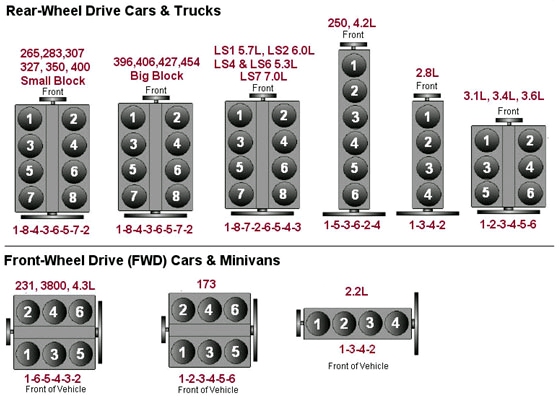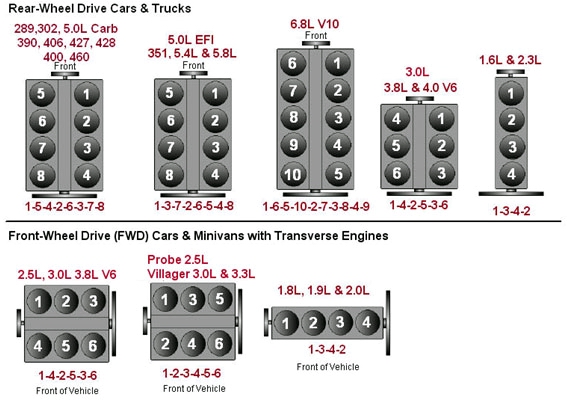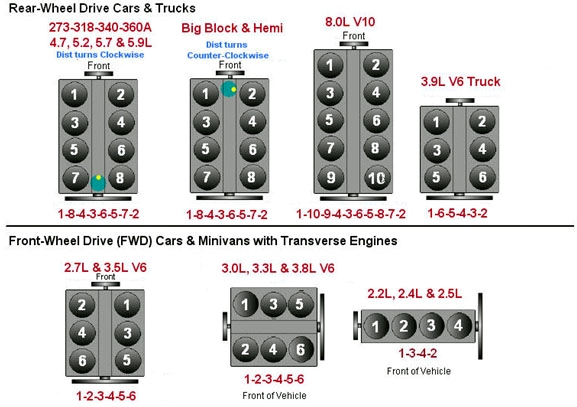
Chevy Firing Order
The firing order of an engine is the sequence the spark plugs fire. On engines with a distributor, the firing order is determined by the routing of the spark plug wires from the distributor cap to the spark plugs in each cylinder. When the piston is at top dead center (TDC) on the compression stroke, the rotor inside the distributor should be aligned with the number one (#1) spark plug terminal in the distributor cap. Depending on which way the distributor rotates (clockwise or counter-clockwise), the next plug wire in the cap would go to the next spark plug in the firing sequence for that engine.
On most Chevrolet engines the #1 cylinder is the first cylinder at the front of the engine on the driver side (left side) of a rear-wheel drive car or truck. On front-wheel drive cars and minivans with a transverse (sideways) mounted V6, the #1 cylinder is the first cylinder on the front side of the engine on the passenger (right) side.
The cylinders are numbered in a staggered sequence going from side-to-side, starting with the #1 cylinder going towards the back of the engine (see illustrations below). So on a V6 or V8 engine, one bank of cylinders would all be odd numbered (all the left cylinders on a rear-wheel drive V6 or V8 engine, or all of the front cylinders on a transverse mounted V6), and the ones on the opposite side would be all even numbered cylinders.

Fig 1. Chevy Firing Orders
The correct firing order is very important because mixing up the spark plug wires may prevent the engine from starting, cause it to backfire and run very poorly if at all.
NOTE: On engines where two adjacent spark plugs fire right after each other, it is important to make sure the spark plug wires are not routed right next to each other for a long distance. This can cause crossfire between the plugs because the magnetic field created by the spark going to one plug may fire the next plug prematurely, causing the engine to run rough and misfire. To prevent this from happening, criss-cross the two plug adjacent plug wires to cancel out the magnetic induction.
On engines with distributorless ignition systems or coil-on-plug ignition systems, the firing order is controlled by the ignition module or engine computer. The computer receives an input signal from the crankshaft position sensor (and camshaft position sensor on some engines) to determine which piston is coming up to top dead center on its compression stroke. It then fires that spark plug, and the next and so on in the firing sequence.
Ford Firing Order
The firing order of an engine is the sequence the spark plugs fire. On engines with a distributor, the firing order is determined by the routing of the spark plug wires from the distributor cap to the spark plugs in each cylinder. When the piston is at top dead center (TDC) on the compression stroke, the rotor inside the distributor should be aligned with the number one (#1) spark plug terminal in the distributor cap. Most (but not all) Ford distributors rotate in a counter-clockwise direction, so the next plug wire in the cap would go to the next spark plug in the firing sequence for that engine.
On most Ford engines the #1 cylinder is the first cylinder at the front of the engine on the passenger side (right side) of a rear-wheel drive car or truck. On front-wheel drive cars and minivans with a transverse (sideways) mounted V6, the #1 cylinder is the first cylinder on the rear side of the engine on the passenger (right) side.
The cylinders are numbered in sequence starting with the #1 cylinder going towards the back of the engine on each cylinder bank (see illustrations below). The only exception is the Nissan V6 in the Probe and Villager, which are numbered in a staggered sequence similar to a GM engine.

Fig 2. Ford Firing Orders

Fig 3. Ford 4.6L V8 "Waste Spark" DIS ignition coils
The correct firing order is very important because mixing up the spark plug wires may prevent the engine from starting, cause it to backfire and run very poorly if at all.
NOTE: On engines where two adjacent spark plugs fire right after each other, it is important to make sure the spark plug wires are not routed right next to each other for a long distance. This can cause crossfire between the plugs because the magnetic field created by the spark going to one plug may fire the next plug prematurely, causing the engine to run rough and misfire. To prevent this from happening, criss-cross the two plug adjacent plug wires to cancel out the magnetic induction.
On engines with distributorless ignition systems or coil-on-plug ignition systems, the firing order is controlled by the ignition module or engine computer. The computer receives an input signal from the crankshaft position sensor (and camshaft position sensor on some engines) to determine which piston is coming up to top dead center on its compression stroke. It then fires that spark plug, and the next and so on in the firing sequence.
Chrysler Firing Orders
The firing order of an engine is the sequence the spark plugs fire. On engines with a distributor, the firing order is determined by the routing of the spark plug wires from the distributor cap to the spark plugs in each cylinder. When the piston is at top dead center (TDC) on the compression stroke, the rotor inside the distributor should be aligned with the number one (#1) spark plug terminal in the distributor cap. Most (but not all) Ford distributors rotate in a counter-clockwise direction, so the next plug wire in the cap would go to the next spark plug in the firing sequence for that engine.
On most Chrysler engines the #1 cylinder is the first cylinder at the front of the engine on the driver side (left side) of a rear-wheel drive car or truck. On front-wheel drive cars and minivans with 2.7L and 3.5L V6 engines, the #1 cylinder is the first cylinder on the front RIGHT side of the engine. On trucks with the 3.9L V6, #1 cylinder is the first cylinder at the front LEFT of the engine.
The cylinders are numbered in a staggered sequence, with all the odd numbers on one side and the even numbers on the other side.

Fig 4. Chrysler Firing Orders
The correct firing order is very important because mixing up the spark plug wires may prevent the engine from starting, cause it to backfire and run very poorly if at all.
On engines with distributorless ignition systems or coil-on-plug ignition systems, the firing order is controlled by the ignition module or engine computer. The computer receives an input signal from the crankshaft position sensor (and camshaft position sensor on some engines) to determine which piston is coming up to top dead center on its compression stroke. It then fires that spark plug, and the next and so on in the firing sequence.
For more information on vehicle electrical systems, please check out the lots more information in RIBO Parts Articles. 
